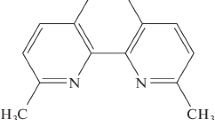Abstract
Isothermal titration calorimetry, potentiometric titration and circular dichroism spectroscopy were used to study the interaction of copper(II) ions with Argireline (Ac-Glu-Glu-Met-Gln-Arg-Arg-NH2) and three of its point mutation derivatives: Glu-Ala-Met-Gln-Arg-Arg-NH2 (AN1), Glu-Ala-His-Gln-Arg-Arg-NH2 (AN2) and Glu-Ala-Met-Gln-Ala-Arg-NH2 (AN3). Under the experimental conditions (20 mmol·L−1 Caco solution, pH 6, 298.15 K), copper(II) ions form 1:1 complexes with the peptides Argireline, AN1, and AN2. The complexation reactions are entropy-driven processes. The stability of the resulting complexes increases in the order log10KCu(AN1) < log10KCu(Argireline) < log10KCu(AN2). The relationship between the point mutations of Argireline and the binding properties of these peptides towards copper(II) ions is discussed.




Similar content being viewed by others
References
Blanes-Mira, C., Clementey, J., Jodasy, G., Gil, A., Fernandez-Ballester, G., Ponsatiy, B., Gutierrezz, L., Perez-Paya, E., Ferrer-Montiel, A.A.: A synthetic hexapeptide (Argireline) with antiwrinkle activity. Int. J. Cosmet. Sci. 24, 303–310 (2002)
Kerscher, M., Buntrock, H.: Update on cosmeceuticals. J. Dtsch. Dermatol. Ges. 9, 314–327 (2011)
Grosicki, M., Latacz, G., Szopa, A., Cukier, A., Kieć-Kononowicz, K.: The study of cellular cytotoxicity of Argireline—an anti-aging peptide. Acta Biochem. Pol. 61, 29–32 (2014)
Kozlowski, H., Bal, W., Dyba, M., Kowalik-Jankowska, T.: Specific structure–stability relations in metallopeptides. Coord. Chem. Rev. 184, 319–346 (1999)
Waggoner, D.J., Bartnikas, T.B., Gitlin, J.D.: The role of copper in neurodegenerative disease. Neurobiol. Dis. 6, 221–230 (1999)
Kozlowski, H., Janicka-Klos, A., Stanczak, P., Valensin, D., Valensin, G., Kulon, K.: Specificity in the Cu2+ interactions with prion protein fragments and related His-rich peptides from mammals to fishes. Coord. Chem. Rev. 252, 1069–1078 (2008)
Rowinska-Zyrek, M., Potocki, S., Remelli, M., Valensin, D.: Specific metal ion binding sites in unstructured regions of proteins. Coord. Chem. Rev. 257, 2625–2638 (2013)
de Ricco, R., Potocki, S., Kozłowski, H., Valensin, D.: NMR investigations of metal interactions with unstructured soluble protein domains. Coord. Chem. Rev. 269, 1–12 (2014)
Pizzanelli, S., Forte, C., Pinzino, C., Magrì, A., La Mendola, D.: Copper(II) complexes with peptides based on the second cell binding site of fibronectin: metal coordination and ligand exchange kinetics. Phys. Chem. Chem. Phys. 18, 3982–3994 (2016)
Draelos, Z.D.: Cosmeceuticals. In: Alam, M., Pongprutthipan, M. (eds.) Body Rejuvenation, 1st edn. Springer, New York (2010)
Reszko, A.E., Berson, D., Lupo, M.: Cosmeceuticals: practical applications. Clin. Dermatol. 27, 401–416 (2009)
Robertson, W.: Wilson’s disease. Arch. Neurol. 57, 276–277 (2000)
Kozłowski, H., Kowalik-Jankowska, T., Jezowska-Bojczuk, M.: Chemical and biological aspects of Cu2+ interactions with peptides and aminoglycosides. Coord. Chem. Rev. 249, 2323–2334 (2005)
Makowska, J., Baginska, K., Skwierawska, A., Liwo, A., Chmurzynski, L., Scheraga, H.A.: Influence of charge and size of terminal amino-acid residues on local conformational states and shape of alanine-based peptides. Biopolymers 90, 772–782 (2008)
Wyrzykowski, D., Zarzeczańska, D., Jacewicz, D., Chmurzyński, L.: Investigation of copper(II) complexation by glycylglycine using isothermal titration calorimetry. J. Therm. Anal. Calorim. 105, 1043–1047 (2011)
Wyrzykowski, D., Pilarski, B., Jacewicz, D., Chmurzyński, L.: Investigation of metal–buffer interactions using isothermal titration calorimetry. J. Therm. Anal. Calorim. 111, 1829–1836 (2013)
Kostrowicki, J., Liwo, A.: A general method for the determination of the stoichiometry of unknown species in multicomponent systems from physicochemical measurements. Comput. Chem. 11, 195–210 (1987)
Kostrowicki, J., Liwo, A.: A determination of equilibrium parameters by minimization of an extended sum of squares. Talanta 37, 645–650 (1990)
Fasman, G.D.: Circular Dichroism and the Conformational Analysis of Biomolecules, p. 738. Plenum Press, New York (1996)
Greenfield, N.J.: Methods to estimate the conformation of proteins and polypeptides from circular dichroism data. Anal. Biochem. 235, 1–10 (1996)
Wyrzykowski, D., Chmurzyński, L.: Thermodynamics of citrate complexation with Mn2+, Co2+, Ni2+ and Zn2+ ions. J. Therm. Anal. Calorim. 102, 61–64 (2010)
Tesmar, A., Wyrzykowski, D., Jacewicz, D., Żamojć, K., Pranczk, J., Chmurzyński, L.: Buffer contribution to formation enthalpy of copper(II)–bicine complex determined by isothermal titration calorimetry method. J. Therm. Anal. Calorim. 126, 97–102 (2016)
Barszcz, B.: Coordination properties of didentate N, O heterocyclic alcohols and aldehydes towards Cu(II), Co(II), Zn(II) and Cd(II) ions in the solid state and aqueous solution. Coord. Chem. Rev. 249, 2259–2276 (2005)
Makowska, J., Bagińska, K., Makowski, M., Jagielska, A., Liwo, A., Kasprzykowski, F., Chmurzyński, L., Scheraga, H.A.: Assessment of two theoretical methods to estimate potentiometric titration curves of peptides: comparison with experiment. J. Phys. Chem. B 110, 4451–4458 (2006)
Rodante, F., Fantauzzi, F., Catalani, G.: Thermodynamics of dipeptides in water. VI. Calorimetric determination of enthalpy changes of dissociation processes in water of the free α-carboxyl and α-amino groups in a series of dipeptides. Comparison of these processes for two series of dipeptides. Thermochim. Acta 311, 43–49 (1998)
Cohn, E.J., Edsall, J.T.: Proteins, Amino Acids and Peptides as Ions and Dipolar Ions. Reinhold Publishing Corporation, New York (1942)
Makowska, J., Bagińska, K., Liwo, A., Chmurzyński, L., Scheraga, H.A.: Influence of charge and size of terminal amino-acid residues on local conformational states and shape of alanine-based peptides. Biopolym. Pept. Sci. 90, 724–732 (2008)
Hamborg, E.S., Versteeg, G.F.: Dissociation constants and thermodynamic properties of amines and alkanolamines from (293 to 353) K. J. Chem. Eng. Data 54, 1318–1328 (2009)
Grimsley, G.R., Scholtz, J.M., Pace, C.N.: A summary of the measured pK values of the ionizable groups in folded proteins. Protein Sci. 18, 247–251 (2009)
Author information
Authors and Affiliations
Corresponding author
Rights and permissions
About this article
Cite this article
Makowska, J., Tesmar, A., Wyrzykowski, D. et al. Investigation of the Binding Properties of the Cosmetic Peptide Argireline and Its Derivatives Towards Copper(II) Ions. J Solution Chem 47, 80–91 (2018). https://doi.org/10.1007/s10953-017-0705-9
Received:
Accepted:
Published:
Issue Date:
DOI: https://doi.org/10.1007/s10953-017-0705-9




